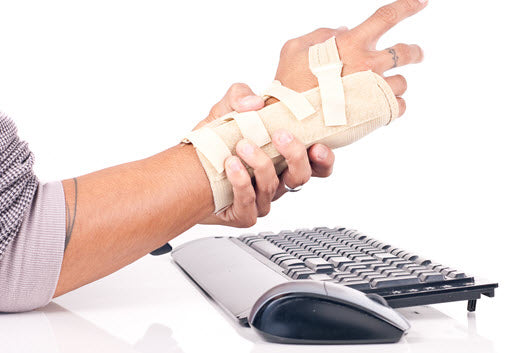While you work, you probably don’t maintain perfect posture all day. Most of us tend to slump or slouch in one direction or another over time—resting your chin on one hand while you read, or even leaning forward, hunching over your keyboard. We spend a lot of hours sitting while working, and when our posture isn’t ideal, it can lead to back pain from straining your neck and other muscles.
Here are five ways that poor ergonomics can have a negative impact on your health:
-
Your Posture Can Suffer

Poor posture can lead to herniated discs and overall muscle weakness. Instead, when you work using an adjustable height computer workstation, you can spend part of your day sitting and part of your day standing. Alternating your position from standing to sitting during your workday can help you maintain better posture, which in turn can help prevent musculoskeletal disorders and back pain. Additionally, the physical movement you’ll add to your day will help increase blood flow, which helps boost oxygen to your brain. That oxygen boost can improve your energy levels throughout the day, as well.
Many people who use a height adjustable standing desk to switch between sitting and standing while they work have noted that switching positions helps them remember to periodically take quick breaks to move around a bit. Staying in one position for too long can also lead to back pain—especially if your posture isn’t always perfect.
-
You May Become Easily Fatigued

Let’s face it: when you’re tired, you aren’t doing your best work. And that’s no good for your overall job performance. But it’s not just about enough sleep, staying hydrated, and a proper diet—although those are also very important for your health! At best, fatigue is annoying, and at worst can lead to safety issues. Your workstation may be contributing to your fatigue, especially if you find yourself sitting in the same position for hours on end.
Don’t maintain the same posture or position for extended periods of time. Stand up, walk around, or do some light stretches for a few minutes every hour or so. Consider alternating part of the day working while sitting, and part of the day working while standing. You can help prevent fatigue as well as hyperextending your knees when you’re standing at your height adjustable standing desk while working by using a non flat anti fatigue mat.
-
You Can Increase Your Risk of Type 2 Diabetes and Heart Disease

Sitting all day seems to be related to reducing the body’s effectiveness in regulating blood sugar known as metabolic syndrome, a precursor to type 2 diabetes. The American Diabetes Association recommends that “All adults, and particularly those with type 2 diabetes, should decrease the amount of time spent in daily sedentary behavior.” Additionally, a recent Kaiser Permanente study suggested that men who spent at least five hours a day sitting had twice the risk of heart failure when compared to those who sit less than two hours a day and exercise often.
-
You May Gain Weight
 Standing burns more calories than sitting. You might need some time to work your way up to standing while working, and that’s where an adjustable height desk comes in. These desks move vertically to the ideal position for you no matter whether you’re sitting or standing. Work toward a goal of standing for about half your workday, but don’t overdo it, or try to do it all at once! Wear comfortable shoes and gradually increase the time you spend standing. You can even try using a timer like the one at standingclock.com to track the time you stand during the day.
Standing burns more calories than sitting. You might need some time to work your way up to standing while working, and that’s where an adjustable height desk comes in. These desks move vertically to the ideal position for you no matter whether you’re sitting or standing. Work toward a goal of standing for about half your workday, but don’t overdo it, or try to do it all at once! Wear comfortable shoes and gradually increase the time you spend standing. You can even try using a timer like the one at standingclock.com to track the time you stand during the day.
-
You May Develop a Musculoskeletal Disorder
 Musculoskeletal Disorders, or MSDs, are issues that affect the body’s movement. The musculoskeletal system consists of bones, ligaments, joints, cartilage, muscles, nerves, discs, and other connective tissue. In other words, the parts of the body that hold everything together as well as upright.
Musculoskeletal Disorders, or MSDs, are issues that affect the body’s movement. The musculoskeletal system consists of bones, ligaments, joints, cartilage, muscles, nerves, discs, and other connective tissue. In other words, the parts of the body that hold everything together as well as upright.
Other terms for MSDs include “repetitive stress injury” and “repetitive motion injury,” but those terms are becoming outdated. Where once it was thought that a single type of repetitive motion could cause MSDs, experts are seeing research that indicates there may be more than one risk factor for these injuries.
Problems collectively referred to as musculoskeletal disorders can include:
- Carpal Tunnel Syndrome
- Radial Tunnel Syndrome
- Tendonitis
- Ruptured or Herniated Disc
- Degenerative Disc Disease
- Trigger Finger/Thumb
- Tendonitis
MSDs can cause discomfort and pain in any part of the body, but back pain is the one of the most common symptoms.


2 comments
Wow, this has changed my life.
Very nice content